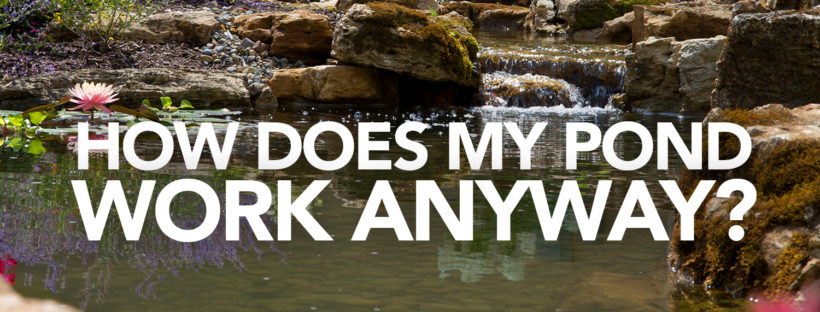This is the number one question I hear as I travel around the country helping people with their water features. Usually there is a problem that brought me to the pond in the first place, but after a few minutes of talking, that question comes up. It is also accompanied with, “I thought this thing was supposed to be low maintenance!” Very quickly I can see that expectations have not been met and a little education is in order.
To many times, during the sales process of a water feature, too much time is spent going over flashy marketing brochures instead of just having an honest conversation about what to expect over the first three years of owning a water feature. Many installers shy away from what the maintenance will be due to a fear of scaring off the potential owner. The truth is, there is maintenance to be done, but it’s not any more than anything else in your back yard.
 So how does your pond work? Your pond works the same way any body of water works whether it’s a 1 gallon goldfish bowl or a seven acre lake. All bodies of water work off of the same basic biology, waste products are created, and bacteria consumes these waste products and converts them into nutrients for plants to consume. With a little maintenance everything will stay in balance and look like a perfect slice of nature. If it is out of balance you will have issues that need addressing.
So how does your pond work? Your pond works the same way any body of water works whether it’s a 1 gallon goldfish bowl or a seven acre lake. All bodies of water work off of the same basic biology, waste products are created, and bacteria consumes these waste products and converts them into nutrients for plants to consume. With a little maintenance everything will stay in balance and look like a perfect slice of nature. If it is out of balance you will have issues that need addressing.
 First and foremost Plants are the answer. Don’t let anyone tell you differently. If you have things growing in your water feature that are green and you didn’t plant them and you don’t like them. It’s because you didn’t plant enough green things you do like. Your grass is the same way, if you don’t re seed the yard, “other” green species will start to grow year after year. So the first thing to remember is plants, plants, plants.
First and foremost Plants are the answer. Don’t let anyone tell you differently. If you have things growing in your water feature that are green and you didn’t plant them and you don’t like them. It’s because you didn’t plant enough green things you do like. Your grass is the same way, if you don’t re seed the yard, “other” green species will start to grow year after year. So the first thing to remember is plants, plants, plants.
Secondly, how many fish do you have? What size are they now compared to when you bought them? Fish grow and as they do their new size creates issues in the water feature. If your fish load doubles in size after the first two years but your plant base stays the same, you are out of balance and will have more maintenance to correct the issue.
Last of all, water flow and filter size. When your feature was created what fish load was use to size the bio filter, do you have enough water flow to filter the feature at least every hour, preferably much more if you have a heavy fish load.
Any of the above can create an out of balance situation for your water feature. There are a multitude of manufactured solutions on the market to aid in this as well. Water clarifiers, automatic dispensers for bacteria, and copper dosing units. Each have their place, and all of them are band aids and not real solutions except for one. Clarifiers only mask the issue, they do clear water, but string algae uses the nutrients and clear water to run out of control. Automatic bacteria dispensers simply take away the need to add bacteria once a week. Truthfully, once the system is in balance this need is reduced as well (more on that in a future blog post).
Then there is the copper system (triton ionizer), it works very good, but is a solution for a specific problem and not for every water feature. Some systems have water issues coming out of the tap and are going to be prone to issues not matter how many plants we add. Others are in an area of the yard where sunlight is great for algae but not plants. So it is a great addition if you find yourself dealing with buckets of algae.
This is just a quick overview of how your water feature works, for a more detailed look please visit Atlantic Water Gardens University.
About the Author:
 SEAN BELL
SEAN BELL
Sean is the Regional Sales Manager for the Southeast for Atlantic Water Gardens. Fish Geek and water feature enthusiast, Sean has managed one of the largest aquarium stores in the Southeast while running his own pond maintenance company. When it comes to water features, Sean is your guy!




Way cool! Some very valid points! I appreciate you penning this write-up
and also the rest of the site is also very good.